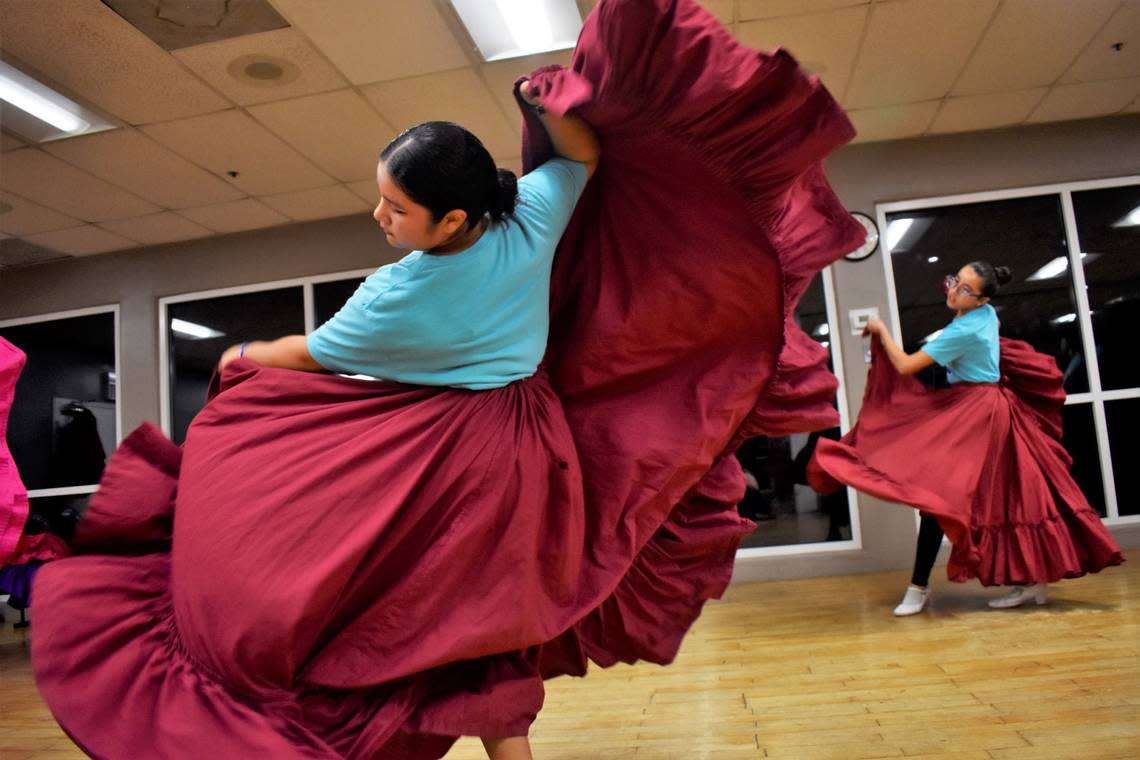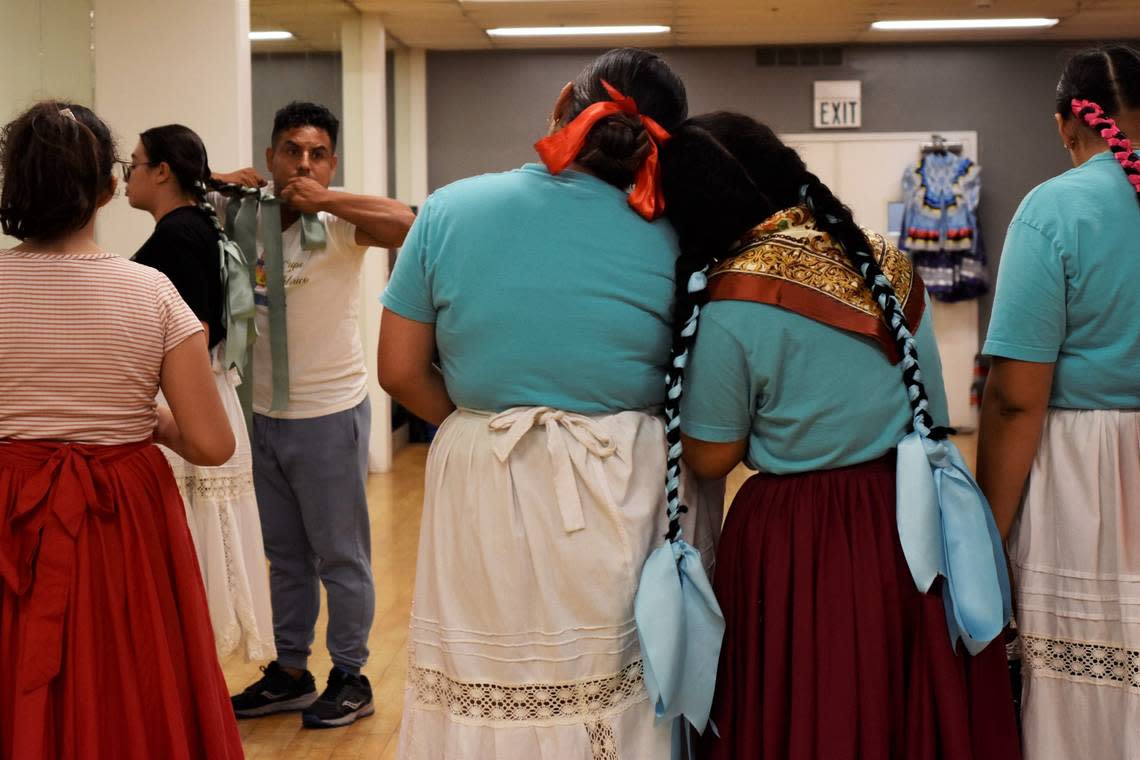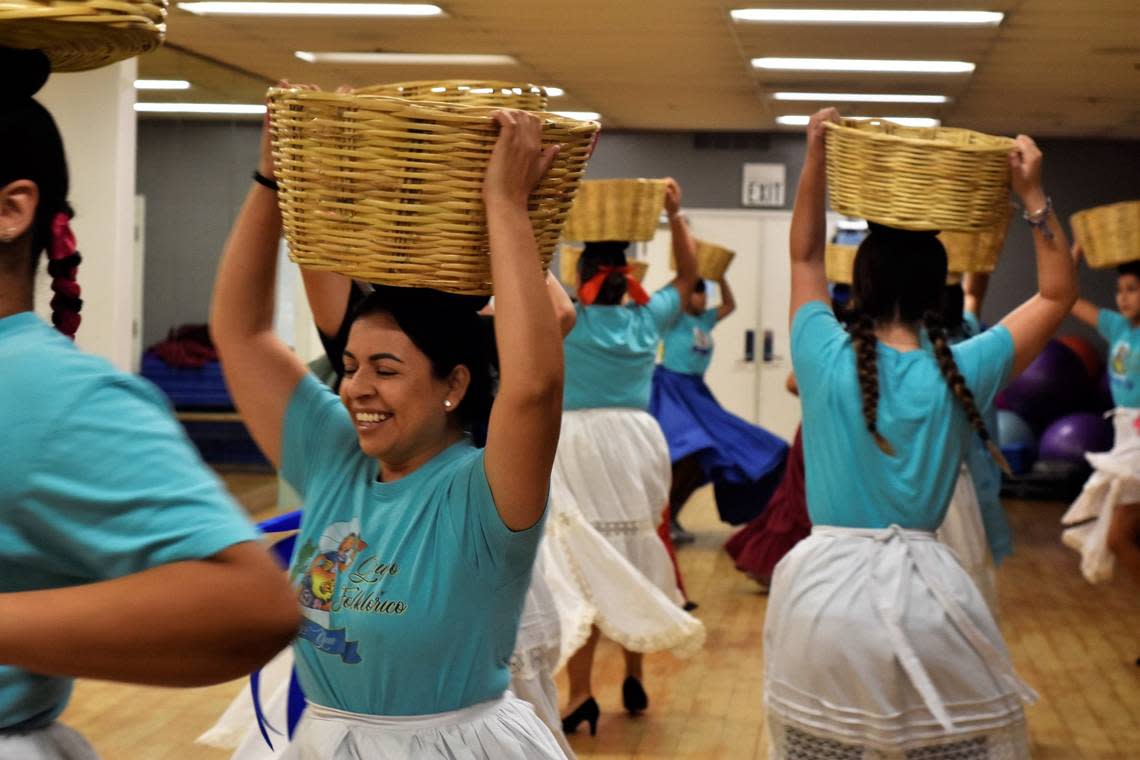This festival brings ‘a piece of Oaxaca’ to Fresno. Meet dancers performing at the event
On a Tuesday night in late September, the members of the folkloric dance group Grupo Folklórico Tangu Yuu practiced their faldeo and zapateo, Mexican dancing with beautiful, wide-flowing skirts and rhythmic stepping.
“With your braids, flowers and headpieces, you are the queens of the moment,” Hugo Martínez, founder and dance director of Tangu Yuu, told the dozen or so dancers — almost all teenage girls — in Spanish.
Grupo Folklórico Tangu Yuu is expected to be the opening act at Fresno’s Guelaguetza (pronounced ge-la-get-zah, with strong G’s) on Sunday at Calwa Park. The event, hosted by the Centro Binacional para el Desarrollo Indígena Oaxaqueño, or the Binational Center for the Development of Oaxacan Indigenous Communities, is returning for its 22nd edition after a two-year hiatus due to the pandemic.
Modeled after a festival that originated in Oaxaca, Mexico in pre-Hispanic times, the local event will include an opening ceremony, food and crafts for sale by local vendors.
For the members of Grupo Folklórico Tangu Yuu, the event is an opportunity to show off their talent and celebrate their heritage.
“A lot of people just know Mexican culture as mariachi hats and ponchos, but things like La Guelaguetza aren’t really known,” said Leylie Garduno, a 17-year-old dancer whose parents are from the Mexican cities of Obregón in Sonora and Mexicali in Baja California.
Though her family is not Oaxacan, she is proud to be part of Fresno’s Guelaguetza this weekend.
“The Guelaguetza is definitely something that’s more tied to the culture, and it makes you feel closer to your culture and your Mexican identity,” Garduno said.

Guelaguetza celebrates Oaxacan culture
The Guelaguetza is one of the most important annual celebrations originating from Oaxaca. Derivative of the Zapotec word “guendalezaa,” Guelaguetza means offering. Typically, people would offer food and crafts to the Zapotec deities as part of the festivities.
The magic of the celebration has carried into current times, where Mexicans — Oaxacans, Indigenous people and anyone wanting to honor the tradition — gather to celebrate with dance, live music and art.
In Fresno, Centro Binacional began celebrating the Guelaguetza locally on the last Sunday of September in 1999. The group’s organizing committee decided to host the event outdoors in September instead of July — when it is traditionally celebrated in Mexico — to avoid the Central Valley’s summer heat.

La Abeja, a newsletter written for and by California Latinos
Sign up here to receive our weekly newsletter centered around Latino issues in California.
Before the pandemic, more than 2,000 people attended the Guelaguetza festivities and organizers hope to see that crowd size again this year, said Sarait Martinez, executive director of Centro Binacional.
“There’s a lot of community members that maybe are not able to go back to their towns of origin,” Martinez said. “Recreating this in Fresno is a way of bringing a piece of Oaxaca to the Central Valley.”
Martinez said that while many celebrations honor Mexican and Latino culture, the Guelaguetza spotlights Oaxacan and Indigenous cultures.
“We’re different in terms of our culture and our language, and bringing that visibility says, ‘we’re here and these are our contributions to the place we live now,’” she said.
These days, community members offer their labor while organizing the event, creating a sense of belonging and pride, Martinez said. She said everyone’s invited to celebrate the Guelaguetza, watch the dances and enjoy the food.
Latinas celebrate their culture with folkloric dance
Grupo Folklórico Tangu Yuu is in the middle of its busiest season ever. They performed dances from Jalisco and Veracruz at Fiestas Patrias, a Latino history and culture celebration that was held in downtown Fresno last weekend. They also have performances lined up before and after Guelaguetza.
Hugo Martínez, a folklórico dancer from Oaxaca himself, started the group to teach the younger generations about Mexican dance and culture. He teaches in Spanish, mixing history, vocabulary and cultural lessons between his dance instruction.
Wanting to honor his Oaxacan roots, he named the group Tangu Yuu after the iconic clay dolls crafted in his home state that are an important folklore symbol.
“It’s pretty much bringing a little piece of Mexico for all of us to have the chance to experience the celebrations there,” he said. “I want them (dancers) to show that up, make the audience feel like they’re in Mexico. Why not?”

Skirts flew as the sound of the zapateo crispened when dancers nailed the steps during a recent rehearsal. The Grupo Folklórico Tangu Yuu girls were visibly enjoying themselves as they chatted and laughed between dance numbers.
“Folklórico has always been a very significant part of my life,” said Andrea Felix-Gastelum, a 17-year-old dancer whose parents are from the cities of Culiacán and Costa Rica in the Mexican state of Sinaloa.
She said dance rehearsals with her Grupo Folklórico Tangu Yuu friends give her a break from the busy schedule she keeps outside the dance studio.
“Here I get to let go of all that and just focus on the here now,” Felix-Gastelum said. “I’m always excited to see my sisters here, so it makes me very sentimental.”
Felix-Gastelum said it’s important for the community to witness events like the Guelagetza because there hasn’t been enough representation of Latino culture in Fresno.
Like fellow dancer Garduno, Felix-Gastelum is proud to participate in the Fiestas Patrias and Guelaguetza festivities.
“It’s really important for the adults to be able to see that their cultures are represented and they mean something here as well as the children of immigrants and the children of people who have moved here and who, like me growing up, felt a little disconnected from their culture,” she said.
